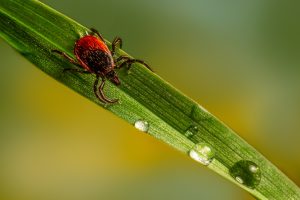PCPR- Lesson 1- Zoonosis
Zoonoses are infections and/or diseases that are passed from animals to people. Such conditions can present a public health concern. Zoonoses can be caused by a range of disease pathogens such as viruses, bacteria, fungi, and parasites. Of 1,415 pathogens known to infect humans, 61% were zoonotic and transmissible from an animal. These diseases can be contracted via urine, feces, respiratory secretions, scratches, and bites from the animal or insects. Most of the zoonotic or infectious diseases listed below are rare, but pet owners do need to be aware of them:
- Anthrax
- Cat scratch fever
- Eastern Equine Encephalomyelitis
- Ercherichia coli
- Giardiasis
- Leptospirosis
- Listeriosis
- Lyme Disease
- Plague Psittacosis Rabies Ringworm Salmonellosis Tetanus
- Tick Paralysis
- Toxoplsmosis
- Tuberculosis

Deer ticks that spread Lyme Disease are very small and sometimes easy to miss.
You are responsible for the prevention of spreading contagious disease. Provide guidance to other people working with an animal as to how they can protect themselves by washing hands, using gloves, and other methods designed to prevent them from contracting a zoonotic disease. Zoonotic diseases are spread from animal to human through contact with infected urine, feces, and bodily secretions or, in some cases, even breathing in infectious agents.
Look for the following:
- Visible signs of a possible medical condition
- Eyes – red, swollen eyes
- Ears – red, tender to the touch and odoriferous
- Rear – sores or leakage
- Sores
- Sensitive areas
- Parasites
- Fleas or little black dots of flea droppings
- Lice
- The condition of the coat for grooming
